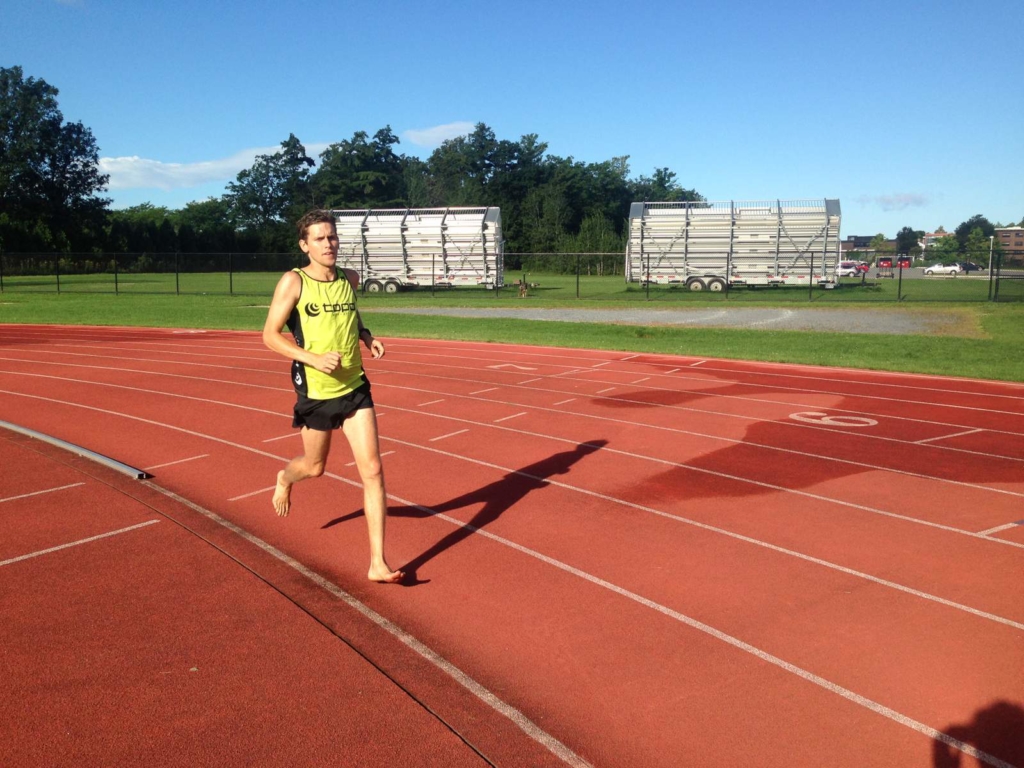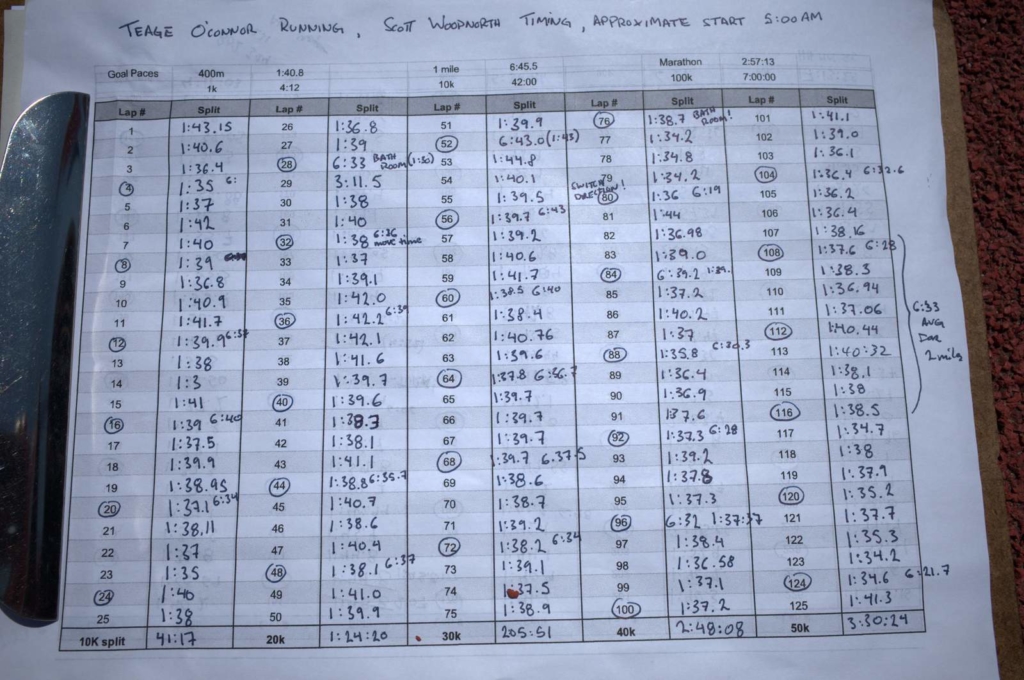Barefoot 100km World Record!!
7h 13m 25s
Woohoo!! Huge thanks to my coach Sam Davis and Scott Woodnorth who were out on the track with me from start to finish, to the Crow’s Path community for raising $1,850 in support of the event, and to the 60+ people that came out to support me throughout the day by running with me, cheering me on, handing me food, and just smiling along the way! Thanks also to Topo Athletic, Barefoot Runners Society, and Merlin Trefethen for support as I trained for this event. I’m left in awe of what a beautiful community I’m apart of, and I’ll be posting more on this aspect of the race on the Crow’s Path blog later this week, but wanted to write a race report here while it’s still fresh.
For a first effort at the distance (well, sort of. I ran the Santa Barbara Tough Enough? 100km, but that’s a different beast altogether), I was pretty darn happy with the effort. I definitely have a lot to learn from the experience, particularly when it comes to pacing as I started out more ambitious than I should have. But there’s always a next time…
Taper:
While keeping intensity of runs the same, I typically drop my volume by 80% the second to last week and then to about 50-60% the last week of training before a peak race. I ran the Mt Mansfield Double Up (1st, with a new course record) a couple of weeks ago and my legs were just thrashed after that race. To speed up my recovery, I got a 2-hour massage from Merlin the Wizard of Ahhhs, who is indeed a magician, (plug: he has super affordable rates). I think the massage would have worked better if I had gone on Monday and not Wednesday, but it was better than nothing. The slow recovery threw off my taper as I wasn’t really capable of running that much – my hobbled legs could only muster about 4 days of running and 30 miles followed by 5 runs and 40 miles last week in prep for the 100km. I was feeling pretty strong by the middle of last week and as I’d had a similar megataper before VCM wasn’t worried about how it might affect my 100km.
Pre-race:
Saturday was a pretty full day with shuttling canoes and gear for the Crow’s Path Adventurers camp, so I wasn’t able to settle down for the evening until around 7pm. Had a pasta dinner and then went to bed at 10pm. I slept soundly and woke up bright and early (2:45am) for a brief shakeout jog to loosen up my legs, then waited impatiently for 4:30am to roll around so I could head to the track. Friend, documentary film maker, and fellow barefoot enthusiasit, Rik Scarce showed up to film a bit and help me load up my gear and send me on my way. I got to the track probably around 4:40 and with my early morning crew, Scott Woodnorth and my most excellent, dedicated and wonderful coach Sam Davis, got my gear/food table set and went over the “plan” for nutrition, pacing, etc. Probably should bring vaseline for chaffing next time. When the “gun” went off, there were a few others enthusiastic track fans, including fan extraordinaire, Annelies, her daughter Zoe, and a couple of Zoe’s friends.
Race:
It was still dark at 5am when I started out, and I struggled to battle patience and excitement in finding a smooth rhythm and wound up oscillating back and forth between 1:36 and 1:42 per lap (6:25/6:48 per mile). When I did get into a groove, it was a bit faster than I had planned on. But I really had no idea what to expect at all from my body when I made my plan – whether my limit was at 6:30 or 7:30 pace was a total unknown, something only experience could determine. I’ve run ultras before but always tend to go out fast and then bonk pretty hard, so I was worried about that, especially after about holding 6:38 pace for 35 miles.
One of my saving graces was Wondu Summa, a 15-year-old runner from BHS who came out to watch (turns out he showed up at 5am too). I’d met Wondu one other time when he introduced himself at the FirstRun 5k. He hopped in at mile 8 and I told him he had one job: to hold the pace at a steady 1:40 400m. We were kept speeding up (my fault) and he’d gently remind me to slow down. A few times I thought he was starting to fall off pace and lag behind, but then he’d remind me we’d sped up and I could tell he was trying to slowly nudge me back on the pace. He ran about 11 miles with me at that pace. That’s 11 miles at 6:38 pace for a 15-year-old. Watchout Vermont, this sophomore will definitely be a top contender over the next 3 years. Rare to see dedication like his at that or any age.
I stopped 2x in the first 2 hours to go to the bathroom, but that was it for the race. Kind of a bummer to not have the port-o-lets closer to the track, probably added about .4 miles total. I sort of sprinted to them because I was worried about time, which was dumb and a waste of precious energy. After the second break I think mentally I was just pumped to get back on track and make up for lost time. I hit a 6:19 and then had to back off quite a bit. They didn’t build Rome in a day and you don’t run a good ultra in the first half of the race. I settled back into 6:28-6:33s for quite a while.
I had expected about 10 or 12 people to come out in total, but was totally blown away with all the support I got, and by 9am I had a steady flow of pacers cycling in and out. This was particularly helpful in the last third of the race. I felt awesome straight through 40 miles, but shortly after it pretty quickly started to get tough, and I knew the last 22.5 would be super challenging. Part of it was a physical thing, but part of it was just the shear weight of thinking about tackling another 22.5 miles after already having run 40. Even at 40 miles, I was still able to stay in a groove, but consciously backed off the pace to 6:45s, trying to hunker down for the long haul. I think I stopped for the first time around mile 48 just to take a break. I really didn’t want to keep going, but Wondu Summa (my hero of the day), Kath Monstream, Brian Pilcher, Binney Mitchell, Peter Gurney, Jim Miller, Adam Bulakowski, Matt Gallagher, and all the others who had been circling the track with me were so amazing and positive and kept drawing my attention away from how much it hurt to how strong I was, what I should name my kid, how cool their elliptigo is, or any number of other distractions I had an increasingly difficult time following.
It was really hard to fight off my brain, which just wanted to focus on how much it hurt and how easy it would be to just stop, but Kath said one lap at a time and so I slowly started ticking away the laps. I stopped more and more to walk, but wasn’t sure if this was a physical or mental lapse. I’m pretty sure mental. As the laps to go got smaller and smaller Brian Pilcher, yes the Brian Pilcher, started counting down the laps in terms of what percentage of the distance remaining that lap represented. 4%, then 5% then 7%, then 10%. I was running with Peter Gurney (below), Kasie Enman (yes, the Kasie Enman), and Marty and started to feel better and better. Running’s been described as 90% physical 10% mental and racing as 90% mental 10% physical. The weight just lifted and I started to fly, I was back on pace 1:43, 1:41, 1:38, 1:34, 1:26, and then I closed in 1:16!! That last lap I was just flying along feeling invincible. I crossed the line and turned around and there was just this huge crowd of fans, supporters, friends, family, and strangers! It was incredible. I yelled “Thank You” and felt a wave of elation run over me. Oh what fun it is to run.

Peter Gurney and I starting to closer hard. I told Peter my only goal was to break 6 on the last lap. Wound up running 5:52 (closed in 77)
Some lessons:
- Feet: My feet were remarkably totally fine. No blisters, no hot spots, no pain. What a relief. I figured they’d be fine as I’d been doing lots of miles sans shoes, but 100km was about 3 times farther than I’ve ever run barefoot.
- Fuel: fueling was great. I used mostly liquid fuels (Honey Stinger gels), but found these to be distasteful after 4 hours. I liked the switch to their chews and found myself wanting more of these. Roasted and salted potatoes were super easy to handle. I used Nuun tablets, which again were really easy on my stomach and tasty enough throughout. I never got sick of this. I probably could have used a more concentrated amount to get more electrolytes. I found almost no interest in bread or PB+Js. My coach noted that my pace quickened after eating, but with about 12 miles to go I just didn’t want to eat anything. So I told my support team to just hand me stuff to eat.
- Fat-taper: I didn’t do a really regimented fat taper diet as I’ve done for the marathon. That may have helped with some of the later stage bonking
- Pace: So this is a super tough one to figure out. With 100km, it’s easy to feel light and relaxed early on when clipping along at easy run pace. It’s hard to anticipate how this will feel 6 hours later. I definitely went too fast in the beginning and really struggled to back off of the pace.
- Training: I put in a solid training block leading up to the race, but I certainly wasn’t in the shape I could have been. I’d only be running 80-95 miles/week and for only 5 weeks (my training block was maybe 7 weeks after VCM. I didn’t have any back-to-back long runs, which probably would have prepared my body for the last 20 miles. My longest long run was only 20 miles.
- Simulation races:Â I think a simulation race or race-like effort, maybe a 30 mile run, would have gone a long way.
In the end, this as an event was a total success. As a race, not my best, but a solid effort. I’m confident in my ability to drop 20 minutes off of this time. Improving on the training stuff above, I really feel like I could have kept it together for the last 15 miles (plus, having a bathroom closer to the race course would’ve shaved 2 minutes off my time).
Here are my splits for the race.








